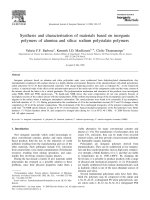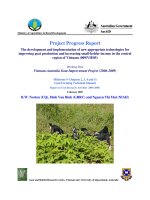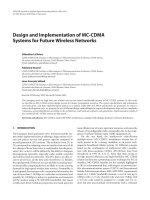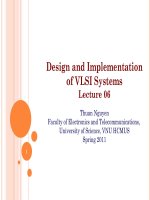Improvement and implementation of analog based method for software project cost estimation
Bạn đang xem bản rút gọn của tài liệu. Xem và tải ngay bản đầy đủ của tài liệu tại đây (2.07 MB, 239 trang )
IMPROVEMENT AND IMPLEMENTATION OF
ANALOGY BASED METHOD FOR SOFTWARE
PROJECT COST ESTIMATION
LI YAN-FU
(B. Eng), WUHAN UNIVERSITY
A THESIS SUBMITTED
FOR THE DEGREE OF DOCTOR OF PHILOSOPHY
DEPARTMENT OF INDUSTRIAL AND SYSTEMS
ENGINEERING
NATIONAL UNIVERSITY OF SINGAPORE
2009
I
Acknowledgements
First and foremost, I would like to record the deepest gratitude to my advisors,
Prof. Xie Min and Prof. Goh Thong Ngee, whose patience, motivation,
guidance and supports from the very beginning to the final stage of my PhD life
enabled me to complete the research works and this thesis.
Besides my advisors, I would like to thank the professors who taught me
lectures and gave me wise advices, the student colleagues who provided me a
stimulating and fun environment, the laboratory technicians and secretaries
who offered me great assistants in many different ways.
I wish to thank my wife and my best friends in NUS for helping me get
through the difficult times, and for all the emotional support, entertainment,
and caring they provided.
Last but not the least, I should present my full regards to my parents who bore
me, raised me, and loved me.
To them I dedicate this thesis.
Yanfu Li
II
Table of Contents
SUMMARY VI
LIST OF TABLES VII
LIST OF FIGURES X
LIST OF ABBREVIATIONS XII
CHAPTER 1 INTRODUCTION 1
1.1 Software Cost Estimation 1
1.2 Introduction to Cost Estimation Methods 3
1.2.1 Expert Judgment Based Estimation 3
1.2.2 Algorithmic Based Estimation 3
1.2.3 Analogy Based Estimation 4
1.3 Motivations 5
1.4 Research Objective 8
CHAPTER 2 LITERATURE REVIEW ON SOFTWARE COST
ESTIMATION METHODS 12
2.1 Introduction 12
2.2 Literature Survey and Classification System 13
2.3 Cost Estimation Methods 18
2.3.1 Expert Judgment 18
2.3.2 Parametric Models 21
2.3.3 Regressions 27
2.3.4 Machine Learning 31
2.3.5 Analogy Based Estimation 37
2.4 Evaluation Criteria 48
2.4.1 Relative Error based Metrics 50
2.4.2 Sum of Square Errors based Metrics 54
2.4.4 Ratio Error based Metrics 58
III
CHAPTER 3 FEATURE SELECTION BASED ON MUTUAL
INFORMATION 60
3.1 Introduction 61
3.2 Mutual Information Based Feature Selection for Analogy Based Estimation 63
3.2.1 Entropy and Mutual Information 63
3.2.2 Mutual Information Calculation 67
3.2.3 Mutual Information Based Feature Selection for Analogy Based Estimation 68
3.3 Experiment Design 70
3.3.1 Evaluation Criteria 71
3.3.2 Data Sets 72
3.3.3 Experiment Design 74
3.4 Results 76
3.4.1 Results on Desharnais Dataset 76
3.4.2 Results on Maxwell Dataset 83
3.4 Summary and Conclusion Remarks 90
CHAPTER 4 PROJECT SELECTION BY GENETIC ALGORITHM 92
4.1 Introduction 93
4.2 Project Selection and Feature Weighting 95
4.3 Experiment Design 103
4.3.1 Datasets 103
4.3.2 Experiment Design 104
4.4 Results 108
4.4.1 Results on Albrecht Dataset 108
4.4.2 Results on Desharnais Dataset 111
4.5 Artificial Datasets and Experiments on Artificial Datasets 113
4.5.1 Generation of Artificial Datasets 114
4.5.2 Results on Artificial Datasets 119
CHAPTER 5 NON-LINEAR ADJUSTMENT BY ARTIFICIAL NEURAL
NETWORKS 123
5.1 Introduction 124
5.2 Non-linearity Adjusted ABE System 125
5.2.1 Motivations 125
5.2.2 Artificial Neural Networks 130
IV
5.2.3 Non-linear Adjusted Analogy Based System 132
5.3 Experiment Design 139
5.3.1 Datasets 139
5.3.2 Experiment Design 143
5.4 Results 146
5.4.1 Results on Albrecht Dataset 146
5.4.2 Results on Desharnais Dataset 150
5.4.3 Results on Maxwell Dataset 153
5.4.4 Results on ISBSG Dataset 155
5.5 Analysis on Dataset Characteristics 158
5.5.1 Artificial Dataset Generation 161
5.5.2 Comparisons on Modeling Accuracies 163
5.5.3 Analysis on ‘Size’ 165
5.5.4 Analysis on ‘Proporti on of categorical features’ 167
5.5.5 Analysis on ‘Degree of non-nor mality’ 168
5.6 Discussions 170
CHAPTER 6 PROBABILISTIC ANALOGY BASED ESTIMATION 173
6.1 Introduction 173
6.2 Formal Model of Analogy Based Estimation 175
6.3 Probabilistic Model of Analogy Based Estimation 177
6.3.1 Assumptions 177
6.3.2 Conditional Distributions 179
6.3.3 Predictive Model and Bayesian Inference 180
6.3.4 Implementation Procedure of Probabilistic Analogy Based Estimation 184
6.4 Experiment Design 185
6.4.1 Datasets 185
6.4.2 Prediction Accuracy 187
6.4.3 Experiment Procedure 191
6.5 Results 192
6.5.1 Results on UIMS Dataset 192
6.5.2 Results on QUES Dataset 195
CHAPTER 7 CONCLUSIONS AND FUTURE WORKS 200
BIBLIOGRAPHY 205
V
APPENDIX A 215
APPENDIX B 218
VI
Summary
Cost estimation is an important issue in project management. The effective
application of project management methodologies often relies on accurate
estimates of project cost. Cost estimation for software project is of particular
importance as a large amount of the software projects suffer from serious
budget overruns. Aiming at accurate cost estimation, several techniques have
been proposed in the past decades. Analogy based estimation, which mimics
the process of project managers making decisions and inherits the formal
expressions of case based reasoning, is one of the most frequently studied
methods.
However, analogy based estimation is often criticized for its relatively poor
predictive accuracy, large computational expense, and intolerance to uncertain
inputs. To alleviate these drawbacks, this thesis is devoted to improve the
analogy based method from three aspects: accuracy, efficiency, and
robustness.
A number of journal/conference papers have been published under this
objective. The research works that have been done are grouped into four
chapters (each chapter is focused on one component of analogy based
estimation): chapter 3 summarizes the work on mutual information based
feature selection technique for similarity function; chapter 4 presents the
research on genetic algorithm based project selection method for historical
database; chapter 5 presents the work on non-linear adjustment to solution
function; chapter 6 presents the probabilistic model of analogy based
estimation with focus on the number of nearest neighbors. The remaining
chapters in this thesis, namely chapters 2 and 7, are the literature review and
the conclusions and future works.
Research in chapters 3 to 5 aims to enhance analogy based estimation‟s
accuracy. For instance, in chapter 5 the adjustment mechanism has been
largely improved for a more accurate analogy based method. Efficiency is
another important aspect of estimation performance. In chapter 3, our study on
refining the historical dataset has achieved a significant reduction of
unnecessary projects and therefore improved the efficiency of analogy based
method. Moreover, in chapter 6 the study on probabilistic model lead to a
more robust and reliable analogy based method tolerable to uncertain inputs.
The promising results show that this thesis makes significant contributions to
the knowledge of analogy based software cost estimation in both the fields of
software engineering and project management.
VII
List of Tables
Table 2.1: Number of publications in each year from 1999 to 2008 16
Table 2.2: Summary of different similarity functions 40
Table 2.3: Summary of papers investigating different number of nearest neighbors 43
Table 2.4: Summary of publications with different solution functions 45
Table 3.1: Comparisons of different feature selection schemes 77
Table 3.2: Selected features in three data splits 78
Table 3.3: Times consumed to optimize feature subset (seconds) 80
Table 3.4: MIABE estimation results on Desharnais Dataset 82
Table 3.5: Comparisons with published results 83
Table 3.6: Comparisons of different feature selection schemes 84
Table 3.7: Selected variables for three splits 86
Table 3.8: Time needed to optimize feature subset (seconds) 87
Table 3.9: MIABE estimation results on Maxwell Dataset 89
Table 3.10: Comparisons with published results 89
Table 4.1: Results of FWPSABE on Albrecht Dataset 109
Table 4.2: The results and comparisons on Albrecht Dataset 110
Table 4.3: Results of FWPSABE on Desharnais Dataset 112
Table 4.4: The results and comparisons on Desharnais Dataset 112
Table 4.5: The partition of artificial data sets 119
Table 4.6: The results and comparisons on artificial moderate non-Normality Dataset 120
VIII
Table 4.7: The results and comparisons on Artificial Severe non-Normality Dataset 121
Table 5.1: Comparison of published adjustment mechanisms 127
Table 5.2: Results of NABE on Albrecht dataset 147
Table 5.3: Accuracy comparison on Albrecht dataset 148
Table 5.4: NABE vs. other methods: p-values of the Wilcoxon tests and the improvements in
percentages 149
Table 5.5: Results of NABE on Desharnais dataset 150
Table 5.6: Accuracy comparisons on Desharnais dataset 151
Table 5.7: NABE vs. other methods: p-values of the Wilcoxon tests and the improvements in
percentages 152
Table 5.8: Results of NABE on Maxwell dataset 153
Table 5.9: Accuracy comparisons on Maxwell dataset 154
Table 5.10: NABE vs. other methods: p-values of the Wilcoxon tests and the improvements in
percentages 155
Table 5.11: Results of NABE on ISBSG dataset 156
Table 5.12: Accuracy comparisons on ISBSG dataset 156
Table 5.13: NABE vs. other methods: p-values of the Wilcoxon tests and the improvements in
percentages 158
Table 5.14: Characteristics of the four real world datasets 159
Table 5.15: Artificial datasets and properties 163
Table 5.16: Comparative performance of NABE to other methods 164
Table 5.17: Testing MMREs under different dataset size 165
Table 5.18: Mann-Whitney U tests of dataset size influences 166
Table 5.19: Testing MMREs under different proportions of categorical features 167
Table 5.20: Wilcoxon tests of proportion of categorical features influences 168
Table 5.21: Testing MMREs under different degrees of non-normality 169
IX
Table 5.22: Wilcoxon tests of non-normality influences 169
Table 6.1: Correlations between CHANGE and OO metrics 187
Table 6.2: Point prediction accuracy on UIMS dataset 192
Table 6.3: Wilcoxon signed-rank test on UIMS dataset 194
Table 6.4: Results of interval prediction at 95% confidence level 195
Table 6.5: Point prediction accuracy on QUES dataset 196
Table 6.6: Wilcoxon signed-rank test on QUES dataset 197
Table 6.7: Results of interval prediction at 95% confidence level 198
X
List of Figures
Figure 1.1: The ABE system structure 6
Figure 1.2: The distribution of research works 9
Figure 2.1: The classification of software cost estimation methods 16
Figure 2.2: The distribution of publications of each class during 1999 - 2008 18
Figure 2.3: Rayleigh function in SLIM model 26
Figure 2.4: An example of artificial neural network 35
Figure 3.1: The relations between mutual information and the entropy 66
Figure 3.2: The schematic diagram of proposed MIABE algorithm 69
Figure 3.3: The boxplots of MRE values of feature selection methods 78
Figure 3.4: Mutual information diagram for the features in three training data splits 80
Figure 3.5: The boxplots of MRE values of feature selection methods (EX is not applicable) 85
Figure 3.6: Mutual information diagram for the features in training dataset 87
Figure 4.1: Chromosome for FWPSABE 97
Figure 4.2: The training stage of FWPSABE 101
Figure 4.3: The testing stage of FWPSABE 103
Figure 4.4: The testing results on Albrecht Dataset 110
Figure 4.5: The testing results on Desharnais Dataset 113
Figure 4.6: Cost versus size of Albrecht dataset 115
Figure 4.7: Cost versus size of Desharnais dataset 115
XI
Figure 4.8: Y versus x
1
sk of moderate non-Normality Data set 118
Figure 4.9: Y versus x
1
sk of severe non-Normality Data set 118
Figure 4.10: The testing results on Artificial Moderate non-Normality Dataset 120
Figure 4.11: The testing results on Artificial Severe non-Normality Dataset 122
Figure 5.1: The general framework of analogy based estimation with adjustment 126
Figure 5.2: Training stage of the ANN adjusted ABE system with K nearest neighbors 136
Figure 5.3: Predicting stage of the ANN adjusted ABE system with K nearest neighbors 138
Figure 5.4: Boxplots of absolute residuals on Albrecht dataset 149
Figure 5.5: Boxplots of absolute residuals on Desharnais dataset 152
Figure 5.6: Boxplots of absolute residuals on Maxwell dataset 155
Figure 5.7: Boxplots of absolute residuals on ISBSG dataset 157
Figure 6.1: Boxplots of Absolute residuals and MREs on UIMS dataset 193
Figure 6.2: Confidence zones on UIMS dataset 195
Figure 6.3: Boxplots of Absolute residuals and MREs on QUES dataset 197
Figure 6.4: Confidence zones on QUES dataset. 198
XII
List of Abbreviations
ABE: Analogy based estimation
ANN: Artificial neural network
BABE: Bootstrapped analogy based estimation
CART: Classification and regression trees
CASE: Computer-aided software engineering
FWABE: Feature weighting for analogy based estimation
FWPSABE: Simultaneous feature weighting and project selection for analogy
based estimation
GABE: Genetic algorithm optimized linear function adjusted analogy based
estimation
KNNR: K-nearest neighbor regression
LABE: Linear function adjusted analogy based estimation
MdMRE: Median Magnitude of Relative Error
MIABE: Mutual information based features selection for analogy based
estimation
MMRE: Mean magnitude of relative error
MRE: Magnitude of relative error
NABE: Non-linear function adjusted analogy based estimation
PABE: Probabilistic model of analogy based estimation
PRED(0.25): Prediction at level 0.25
PSABE: Project selection for analogy based estimation
RABE: „Regression toward the mean‟ adjusted analogy based estimation
RBF: Radial basis function networks
SABE: Similarity function adjusted analogy based estimation
OLS: Ordinary least square regression
SVR: Support vector regression
SWR: Stepwise regression
Chapter I. Introduction
1
Chapter 1 Introduction
Recently, the software industry has faced a dramatic increase in the
demand of new software products. On the other hand, software became more
and more complex and difficult to produce and maintain. This demand-supply
contradiction has contributed to the continuous improvements on software
project management in which the ultimate goal is producing low cost and high
quality software in short time. Successful software project management
requires effective planning and scheduling supported by a group of activities,
among which estimating the development cost (or effort) is fundamental to
guide other activities. This task is known as Software Cost Estimation.
Software cost estimation is a very active research field as it was more than 30
years ago, when the difficulties of estimation were discussed in “The Mythical
Man Month” (Brooks 1975).
1.1 Software Cost Estimation
Cost estimation is a critical issue in project management (Chen 2007,
Henry et al. 2007, Pollack-Johnson and Liberatore 2006). It is particularly
important for software projects, as numerous software projects suffer from
overruns (Standing 2004) and accurate cost estimation is one of the key points
to the success of software project management.
Chapter I. Introduction
2
Software cost (or effort) estimation is the process of predicting the
amount of effort required to build a software system (Boehm 1981). It is a
continuous activity which can or must start at the early stage of the software
life cycle and continues throughout the life time. During the first phases of
software life cycle, cost estimation is of necessity for software developing
team to decide whether or not to proceed, though accurate estimates are
obtained with great difficulties at this point due to the wrong assumptions or
imprecise data. During the middle phases, the cost estimates are useful for
rough validation and process monitoring. After completion, cost estimates are
useful for project productivity assessment.
Since the software cost estimation affects almost all aspects of software
project development such as bidding, budgeting, planning and risk analysis.
The estimation has great impacts on software project management. If the
estimation is too low, then the software development will be running under
considerable constraints to finish the product in time, and the resulting
software may not be fully functional or tested. On the other hand, if the
estimation is too high, then too many resources will be committed to the
project and this may result in significant amount of wasted resources.
Furthermore, if the company is engaged in a contract, then too high an
estimate may lead to loss of business opportunity.
Despite its importance, the estimation of software cost is still a weakness
in software project management. Aiming at accurate and robust estimation,
Chapter I. Introduction
3
various cost estimation techniques have been proposed in past decades.
Section 1.2 presents a brief introduction to these techniques including our
research focus: analogy based estimation.
1.2 Introduction to Cost Estimation Methods
According to Angelis and Stamelos (2000)‟s classification system, cost
estimation methods can be grouped under three categories: expert judgment,
algorithmic estimation, and analogy based estimation.
1.2.1 Expert Judgment Based Estimation
Expert judgment requires the consultation of one or more experts to
derive the cost estimate (Hughes 1996). A Dutch study carried out by
Heemstra (1992) revealed that 62% of estimators/organizations use this
intuition technique and a study carried out later by Vigder and Kark (1994)
also confirmed the widespread use of this technique. Despite its popularity
this method seems to have received a poor reputation and it is often regarded
as subjective and unstructured which makes it vulnerable compared with more
structured methods (Angelis and Stamelos 2000).
1.2.2 Algorithmic Based Estimation
To date, the algorithmic method is the most popular technique in the
literature. In algorithmic method, cost value is estimated by using certain
Chapter I. Introduction
4
mathematical function to link it to the inputs metrics such as „line of source
code‟ and „function points‟. The mathematical model is often built upon some
information abstracted from historical projects. Algorithmic method has some
advantages over expert judgment: it has well defined formal structure; it
produces identical outputs given the same inputs; it is efficient and good for
sensitivity analysis (Selby and Boehm 2007).
The algorithmic method consists of a large number of techniques which
can be further divided into two classes: function based methods and machine
learning methods. Examples of function based methods are: COCOMO model
(Boehm 1981), Function Points Analysis (Albrecht and Gaffney 1983), SLIM
model (Putnam 1978), and Regressions (Schroeder et al. 1986). Examples of
machine learning methods are: Artificial Neural Networks (Srinivasan and
Fisher 1995), Classification and Regression Trees (CART) (Brieman et al.
1984).
1.2.3 Analogy Based Estimation
Analogy based estimation (Shepperd and Schofield 1997) is the process
of identifying one or more historical projects that are similar to the project
being developed and deriving the estimates from the similar historical projects.
This technique is intended to mimic the process of an expert making decisions
based on his/her experience. On the other hand, analogy based estimation has
a concrete and well-defined estimation framework, given that similar past
Chapter I. Introduction
5
projects can be easily retrieved and the mechanism applying the nearest
neighbors is correct. Thus, analogy based estimation is a very flexible method
which allows the combination of the good aspects in both algorithmic
methods and expert judgment. It has several advantages such as: it is able to
deal with poorly understood domains, its output is relatively easy to interpret,
and it offers the chance to learn from past experiences (Walkerden and Jeffery
1999).
1.3 Motivations
As explained in the previous section, analogy based estimation is one
successful technique for cost estimation. However, it also has been criticized
for relatively poor predictive accuracy, large computational expense, and
intolerance to uncertainties. To overcome these drawbacks, many research
works have been focusing on improving the four key components of analogy
based system: similarity function, historical database, number of retrieved
nearest neighbors and solution function (shown in Fig 1.1).
Similarity function (Shepperd and Schofield 1997), which measures the
level of similarity between two different projects, is one of the key
components in analogy based system. The choice of measure is an important
issue since it affects the projects to be selected as the nearest neighbors. Many
works (Auer et al., 2006, Huang and Chiu, 2006, Mendes et al., 2003) have
been devoted to optimize the similarity function or feature weights, and the
Chapter I. Introduction
6
prediction accuracy of the analogy based system was reported to be
significantly improved if the appropriate similarity functions or feature
weights have been selected.
The historical database is the storage of the past projects‟ information,
and it is used to retrieve the nearest neighbors. However, due to the instability
of software development process the historical databases always contain noisy
or redundant projects which might ultimately hinder the prediction accuracy
of analogy based estimation. One possible solution is to reduce the whole
database into smaller subset that consists of merely the representative projects.
Similarity function
Input
projects
Predicted value
Historical
projects
Solution function
Retrieve k nearest
neighbors
ABE system
Figure 1.1: The ABE system structure
Chapter I. Introduction
7
Despite the importance of subset selection, very few research works (Kirsopp
and Shepperd 2002) have been focused on this topic.
The number K of retrieved nearest neighbors decides how many nearest
neighbors should be selected for the solution function to generate final
prediction. Many works (Li and Ruhe. 2008, Mittas et al. 2008, Auer et al.
2006, Mendes et al. 2003, Leung 2002) have investigated the impacts of this
value on the estimation results and/or considered optimizing this value.
However, to our knowledge there is no widely accepted technique to choose K
except the empirical trial-and-error method. Therefore, it is of great interest to
develop systematic ways to optimize this parameter.
The solution function calculates the final estimation results from the
nearest neighbors retrieved from the historical database. If an appropriate
solution function is used, the prediction performance of analogy based system
could be improved significantly. In the literature, only linear solution
functions (Chiu and Huang, 2007, Jorgensen et al., 2003) have been
considered though the relationships between the cost value and input features
are usually non-linear. There is still a lack of research works to investigate the
feasibility of applying non-linear solution functions.
As discussed above, many studies have been devoted to achieve accurate
prediction by improving the four components of the analogy based system;
however there still exists great opportunities to improve analogy based
estimation for better performance. Moreover, most of the previous studies
Chapter I. Introduction
8
merely focused on improving accuracy which is one aspect of performance.
The robustness, which is another important indicator, has received few
concerns. As budget uncertainty is an important issue in project management
(Yang 2005, Barraza and Bueno 2007), some authors pointed out that it is
safer to generate probabilistic predictions such as probability distributions of
the effort values or interval estimates with a probability. However, very little
research (Angelis and Stamelos 2000, Jorgensen and Sjoberg 2003, van Koten
and Gray 2006) has been done on probabilistic predictions.
1.4 Research Objective
The objective of this thesis is to improve accuracy, efficiency and
robustness of analogy based estimation. Accuracy is the indicator of the cost
estimator‟s ability to produce the quality predictions that match the software
projects‟ costs. Efficiency is the speed of the cost estimator to complete a
certain amount of estimation tasks. Robustness reflects the cost estimator‟s
tolerance to uncertain inputs such as missing values and noisy data.
A number of journal/conference papers have been published under this
objective. The research works that have been done are grouped into four
chapters (each chapter is focused on one component of analogy based
estimation): chapter 3 summarizes the works on mutual information based
feature selection technique for similarity function; chapter 4 presents the
research on genetic algorithm based project selection method for historical
Chapter I. Introduction
9
database; chapter 5 presents the work on non-linear adjustment to solution
function; chapter 6 presents the probabilistic model of analogy based
estimation which is focused on the number of nearest neighbors. The
distribution of chapters 3 to 6 in the framework of analogy based system is
illustrated in fig 1.2 where the shaded boxes with characters „CH‟ stand for
chapters (e.g. CH 3 stands for chapter 3). The remaining chapters in this thesis,
namely chapters 2 and 7, are the literature review and the conclusions.
All of our research works share a common objective - enhance the
analogy based estimation‟s capability to achieve more accurate results. In
Similarity function
Input
projects
Predicted value
Historical
projects
Solution function
CH 4
CH 5
CH 6
Retrieve k nearest
neighbors
CH 3
ABE system
Adjustment
Figure 1.2: The ABE system structure and distributions of the research works
Figure 1.2: The distribution of research works
Chapter I. Introduction
10
practice, this is very important for the software enterprises to maintain a better
control of the budget throughout their software development processes.
Theoretically speaking, these studies have contributed to the optimization of
individual component of analogy based system. For instance, historical
database and solution function have been largely refined or improved in our
works. Furthermore, these studies point out a feasible direction to the global
optimization of analogy based system.
Efficiency is another important aspect of estimation performance. In
practice, improving estimation efficiency means enhancing the chance of
winning bids. Many machine learning methods such as ANN and RBF can be
very accurate in some situations, but they are often suffering from slow
training speed. In addition, expert judgment could also be time consuming, as
it usually takes time to gather/interview experts. Our studies on refining the
historical dataset of analogy based system have achieved a significant
reduction of unnecessary projects. Consequently, the efficiency of analogy
based system is largely improved by our algorithm.
Moreover, the studies on probabilistic model lead to a more robust and
reliable analogy based system. These studies could enhance the system‟s
capability to deal with a broader scope of situations such as missing values
and ambiguous inputs. Additionally, the probabilistic prediction provides a
feasible way to model the inherited uncertainties and variabilities in the
software development process.
Chapter I. Introduction
11
As mentioned above, our research on analogy based estimation is of
significant theoretical value and practical value. For a better understanding of
our research work, the detailed background information of our research work
is presented in the literature review in next chapter.
Chapter II. Literature Review on Software Cost Estimation Methods
12
Chapter 2 Literature
Review on Software Cost
Estimation Methods
To obtain accurate software project cost estimates, various kinds of
methods have been proposed. This chapter provides a detailed summary of the
software cost estimation methods published in the past decade. The evaluation
criteria for the prediction accuracy of these methods are also summarized and
analyzed.
2.1 Introduction
In the literature there are several comprehensive overviews on the cost
estimation methods, such as Walkerden and Jeffery (1997), Boehm et al.
(2000), Briand and Wieczorek (2002), Jorgensen (2004a) and Jorgensen and
Shepperd (2007). Among them, some reviews (Walkerden and Jeffery 1997,
Boehm et al. 2000, Briand and Wieczorek 2002) have proposed different
classification systems.
Walkerden and Jeffery (1997) introduced a system with four classes of
estimation methods: empirical, analogical, theoretical, and heuristic. However,
they stated that expert judgment cannot be included into their system.
Moreover, there are overlaps between analogical and empirical, as analogical









